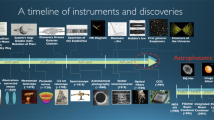Abstract
This chapter presents an introduction to the techniques and tools used in astronomy and astrophysics research, mainly focused on spectroscopy. The basic concepts of spectroscopy are first described, from the Schrödinger equation to the Lambert–Beer’s law. The spectroscopy of solid systems, widely found in astronomical media, is studied in more detail. An introduction is provided also to the basic concepts of astronomical observations, and the information that can be obtained from them, both in the gas phase and in solid systems. An appendix is included with conversion factors for some of the many magnitudes and units employed in this area.
Access this chapter
Tax calculation will be finalised at checkout
Purchases are for personal use only
Similar content being viewed by others
Notes
- 1.
There might arise some confusion with the i and f nomenclature for energy levels in Sect. 3.3 above, which is more usually employed in spectroscopy. Subindices i and f refer to the initial and final states of a transition, whereas l and u refer to the lower and upper states. They coincide for absorptions but have the opposite meaning for emissions.
References
Electromagnetic Radiation, Quantum Mechanics:
Atkins, P.W.: Molecular Quantum Mechanics. Clarendon, Oxford (1970)
Pauling, L., Wilson, E.B.: Introduction to Quantum Mechanics. McGraw Hill, New York (1935)
Spectroscopy:
Herzberg, G.: Molecular Spectra and Molecular Structure (3 Volumes). Krieger, Malabar, FL (1991)
Wilson, E.B., Decius, J.C., Cross, P.C.: Molecular Vibrations. McGraw Hill, New York (1955)
Solid State:
Born, M., Kun, H.: Dynamical Theory of Crystal Lattices. Clarendon, Oxford (1988)
Decius, J.C., Hexter, R.M.: Molecular Vibrations in Crystals. McGraw Hill, New York (1977)
Ovchinnikov, M.A., Wight, C.A.: J. Chem. Phys. 99, 3374 (1993)
Theoretical Calculations:
Jensen, P., Bunker, P.R.: Computational Molecular Spectroscopy. Wiley, Chichester (2003)
SIESTA:
Ordejón, P., Artacho, E., Soler, J.M.: Phys. Rev. B Condens. Matter. 53, R10441 (1996)
Soler, J.M., et al.: J. Phys. Condens. Matter. 14, 2745 (2002)
CASTEP:
Clark, S.J., et al.: Z. Kistallogr. 220, 567 (2005)
Units and Conversion Factors:
Mills, I.M., et al.: Quantities, Units and Symbols in Physical Chemistry, IUPAC. Blackwell, Oxford (1988)
Pugh, L.A., Narahari Rao, K.: Intensities from Infrared Spectra. In: Ch. 4 in Molecular Spectroscopy: Modern Research. Academic, New York (1976)
Radioastronomy:
Kraus, J.D.: Radio Astronomy, 2nd edn. Cygnus-Quasar, Powell, OH (1986)
Wilson, T.L., Rohlfs, K., Hüttemeister, S.: Tools of Radio Astronomy. Springer (2017)
Specific References:
Escribano, R.M., et al.: Proc. Natl. Acad. Sci. U.S.A. 110, 12899 (2013)
Fernández-Torre, D.: Ph.D. Thesis, Universidad Complutense, Madrid (2005)
Acknowledgments
We gratefully acknowledge financial support from Projects FIS2016-C331P, AYA2014-60585-P and AYA2015-71975-REDT of the Spanish MINECO. We are grateful to Angel González Valdenebro for help with the figures.
Author information
Authors and Affiliations
Corresponding author
Editor information
Editors and Affiliations
Appendix: Units and Conversion Factors
Appendix: Units and Conversion Factors
Several units are used in spectroscopy which are especially suitable for specific spectral regions, or traditionally used by spectroscopists or astrophysicists. Some of them are listed below, where <> means equivalent to, and c = 2.99792458 × 1010 cm s−1, Avogadro’s number NA = 6.0221367 × 1023 molec mol−1, Boltzman’s constant k = 1.38064852 × 10−23 m2 kg s−2 K−1 (1.38064852 × 10−16 erg K−1 in cgs units) and Planck’s constant h = 6.6260755 × 10−34 J s:
Frequency ν (microwave region) to wavenumber \( \overline{\nu} \): 1 GHz = 109 Hz <> 1/c cm−1= 3.33564 ×10 −2 cm−1; 1 kHz = 103 Hz <> 3.33564 × 10−8 cm−1.
Wavenumber \( \overline{\nu} \) (infrared region) to wavelength λ: mid-IR region: 1000 cm−1 <>10 μm; 3000 cm−1 <> 3.333 μm; near-IR region: 6000 cm−1 <> 1.6 μm.
Wavelength λ (visible and UV regions) to energy E: 1 μm <> (hc/λ) 1.986447 × 10−19 J <> (hcNA/λ) 11.96266 × 104 J mol−1; 665 nm (approx. red light) <> 17.98899 × 104 J mol−1.
Other energy units (X-ray region): 100 eV <> 9.64853 × 106 J mol−1 <> 1.23984× 10−2 μm.
Rights and permissions
Copyright information
© 2018 Springer International Publishing AG, part of Springer Nature
About this chapter
Cite this chapter
Escribano, R., Muñoz Caro, G.M. (2018). Introduction to Spectroscopy and Astronomical Observations. In: Muñoz Caro, G., Escribano, R. (eds) Laboratory Astrophysics . Astrophysics and Space Science Library, vol 451. Springer, Cham. https://doi.org/10.1007/978-3-319-90020-9_3
Download citation
DOI: https://doi.org/10.1007/978-3-319-90020-9_3
Published:
Publisher Name: Springer, Cham
Print ISBN: 978-3-319-90019-3
Online ISBN: 978-3-319-90020-9
eBook Packages: Physics and AstronomyPhysics and Astronomy (R0)




